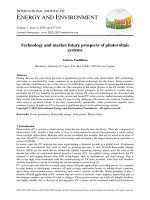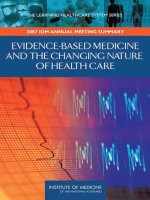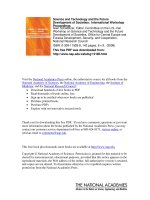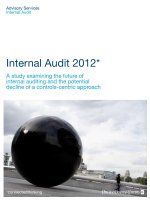Science and Technology and the Future Development of Societies: International Workshop Proceedings doc
Bạn đang xem bản rút gọn của tài liệu. Xem và tải ngay bản đầy đủ của tài liệu tại đây (1.02 MB, 143 trang )
Visit the
National Academies Press online, the authoritative source for all books from the
National Academy of Sciences, the National Academy of Engineering, the Institute of
Medicine, and the National Research Council:
• Download hundreds of free books in PDF
• Read thousands of books online, free
• Sign up to be notified when new books are published
• Purchase printed books
• Purchase PDFs
• Explore with our innovative research tools
Thank you for downloading this free PDF. If you have comments, questions or just want
more information about the books published by the National Academies Press, you may
contact our customer service department toll-free at 888-624-8373,
visit us online, or
send an email to
This free book plus thousands more books are available at
.
Copyright © National Academy of Sciences. Permission is granted for this material to be
shared for noncommercial, educational purposes, provided that this notice appears on the
reproduced materials, the Web address of the online, full authoritative version is retained,
and copies are not altered. To disseminate otherwise or to republish requires written
permission from the National Academies Press.
ISBN: 0-309-11928-6, 142 pages, 6 x 9, (2008)
This free PDF was downloaded from:
/>Science and Technology and the Future
Development of Societies: International Workshop
Proceedings
Glen Schweitzer, Editor, Committee on the U.S Iran
Workshop on Science and Technology and the Future
Development of Societies, Office for Central Europe and
Eurasia Development, Security, and Cooperation,
National Research Council
Copyright © National Academy of Sciences. All rights reserved.
Science and Technology and the Future Development of Societies: International Workshop Proceedings
/>Glenn Schweitzer, Editor
Committee on the U.S Iran Workshop on Science and Technology and the
Future Development of Societies
Office for Central Europe and Eurasia
Development, Security, and Cooperation
Policy and Global Affairs
Copyright © National Academy of Sciences. All rights reserved.
Science and Technology and the Future Development of Societies: International Workshop Proceedings
/>THE NATIONAL ACADEMIES PRESS 500 Fifth Street, N.W. Washington, DC 20001
NOTICE: The project that is the subject of this report was approved by the Governing
Board of the National Research Council, whose members are drawn from the councils of
the National Academy of Sciences, the National Academy of Engineering, and the Institute
of Medicine. The members of the committee responsible for the report were chosen for
their special competences and with regard for appropriate balance.
Any opinions, findings, conclusions, or recommendations expressed in this publication
are those of the author(s) and do not necessarily reflect the views of the organizations or
agencies that provided support for the project.
International Standard Book Number-13: 978-0-309-11927-6
International Standard Book Number-10: 0-309-11927-8
A limited number of copies are available from the Office for Central Europe and Eur-
asia, National Research Council, 500 Fifth Street, N.W., Washington, DC 20001; (202)
334-2376.
Additional copies of this report are available from the National Academies Press, 500 Fifth
Street, N.W., Lockbox 285, Washington, DC 20055; (800) 624-6242 or (202) 334-3313
(in the Washington metropolitan area); Internet, .
Copyright 2008 by the National Academy of Sciences. All rights reserved.
Printed in the United States of America.
Copyright © National Academy of Sciences. All rights reserved.
Science and Technology and the Future Development of Societies: International Workshop Proceedings
/>The National Academy of Sciences is a private, nonprofit, self-perpetuating society of
distinguished scholars engaged in scientific and engineering research, dedicated to the
furtherance of science and technology and to their use for the general welfare. Upon the
authority of the charter granted to it by the Congress in 1863, the Academy has a man-
date that requires it to advise the federal government on scientific and technical matters.
Dr. Ralph J. Cicerone is president of the National Academy of Sciences.
The National Academy of Engineering was established in 1964, under the charter of
the National Academy of Sciences, as a parallel organization of outstanding engineers.
It is autonomous in its administration and in the selection of its members, sharing with
the National Academy of Sciences the responsibility for advising the federal government.
The National Academy of Engineering also sponsors engineering programs aimed at
meeting national needs, encourages education and research, and recognizes the superior
achievements of engineers. Dr. Charles M. Vest is president of the National Academy of
Engineering.
The Institute of Medicine was established in 1970 by the National Academy of Sciences
to secure the services of eminent members of appropriate professions in the examina-
tion of policy matters pertaining to the health of the public. The Institute acts under the
responsibility given to the National Academy of Sciences by its congressional charter to
be an adviser to the federal government and, upon its own initiative, to identify issues of
medical care, research, and education. Dr. Harvey V. Fineberg is president of the Institute
of Medicine.
The National Research Council was organized by the National Academy of Sciences in
1916 to associate the broad community of science and technology with the Academy’s
purposes of furthering knowledge and advising the federal government. Functioning in
accordance with general policies determined by the Academy, the Council has become the
principal operating agency of both the National Academy of Sciences and the National
Academy of Engineering in providing services to the government, the public, and the
scientific and engineering communities. The Council is administered jointly by both
Academies and the Institute of Medicine. Dr. Ralph J. Cicerone and Dr. Charles M. Vest
are chair and vice chair, respectively, of the National Research Council.
www.national-academies.org
Copyright © National Academy of Sciences. All rights reserved.
Science and Technology and the Future Development of Societies: International Workshop Proceedings
/>Copyright © National Academy of Sciences. All rights reserved.
Science and Technology and the Future Development of Societies: International Workshop Proceedings
/>v
NATIONAL RESEARCH COUNCIL COMMITTEE ON THE
U.S IRAN WORKSHOP ON SCIENCE AND TECHNOLOGY
AND THE FUTURE DEVELOPMENT OF SOCIETIES
George Bugliarello, Chair, President Emeritus and University Professor,
Polytechnic University
David R. Challoner, Vice President for Health Affairs, Emeritus, University of
Florida
Michael T. Clegg, Donald Bren Professor of Biological Sciences, University of
California, Irvine
Staff
Glenn E. Schweitzer, Program Director, The National Academies
A. Chelsea Sharber, Senior Program Associate, The National Academies
Elizabeth D. Keller, Mirzayan Science Policy Graduate Fellow, The National
Academies
Merc Fox, Senior Program Assistant, The National Academies
Copyright © National Academy of Sciences. All rights reserved.
Science and Technology and the Future Development of Societies: International Workshop Proceedings
/>Copyright © National Academy of Sciences. All rights reserved.
Science and Technology and the Future Development of Societies: International Workshop Proceedings
/>vii
I
n June 2006, seventeen scientists and educators selected by the National
Academies, the Academy of Sciences of Iran, and the Académie des Sciences
of France held a workshop at the estate of the Fondation des Treilles in
Toutour, France, to discuss issues concerning the role of science in the develop-
ment of modern societies. This location was an idyllic setting for relaxed conver-
sations, while simplifying travel and visa arrangements for the participants. The
three academies had organized a related workshop on food safety and security,
global energy transitions, and education issues at the estate in 2003; the success
of that workshop was a strong incentive to return to Toutour.
This report includes the presentations made at the workshop and summa-
rizes the discussions that followed the presentations. The statements made in
the enclosed papers are those of the individual authors and do not necessarily
represent positions of the National Academies. Unfortunately, three of the Iranian
specialists and one American specialist who were scheduled to participate were
unable to travel to France. However, they provided the papers that they intended
to present. These papers are included in the appendixes of the report.
An important observation of the participants was that the topics that were
addressed, particularly the inclusion of science-oriented themes throughout the
K-12 education curriculum, warranted more detailed discussions between Iranian
and Western colleagues. The National Academies are currently exploring oppor-
tunities to continue such discussions in Iran, and this report provides useful
background for the further development of interactions of Western scientists and
educators with Iranian specialists.
Preface
Copyright © National Academy of Sciences. All rights reserved.
Science and Technology and the Future Development of Societies: International Workshop Proceedings
/>viii PREFACE
ACKNOWLEDGMENTS
This volume has been reviewed in draft form by individuals chosen for their
technical expertise, in accordance with procedures approved by the National
Research Council’s Report Review Committee. The purpose of such an indepen-
dent review is to provide candid and critical comments that will assist the insti-
tution in making its published report as sound as possible and to ensure that the
report meets institutional standards for quality. The review comments and draft
manuscript remain confidential to protect the integrity of the process.
We wish to thank the following individuals for their review of selected papers:
R. Stephen Berry, University of Chicago; James Childress, University of Virginia;
Denis Gray, North Carolina State University; Janet Hustler, Synopsys, Inc.;
Richard McCray, University of Colorado at Boulder; Wilhelmine Miller, George
Washington University; and Andrew Schrank, University of New Mexico.
Although the reviewers listed above have provided constructive comments
and suggestions, they were not asked to endorse the content of the individual
papers. Responsibility for the final content of the papers rests with the individual
authors and the institution.
George Bugliarello
Chair, National Research Council Committee on
the U.S Iran Workshop on Science and Technology
and the Future Development of Societies
Glenn E. Schweitzer
Director, Office for Central Europe and Eurasia,
National Research Council
Copyright © National Academy of Sciences. All rights reserved.
Science and Technology and the Future Development of Societies: International Workshop Proceedings
/>ix
SCIENCE AND SOCIETY ISSUES
The Role of Communications and Scientific Thinking 3
Barbara Schaal
Knowledge, Validation, and Transfer: Science, Communication, and
Economic Development 5
John Enderby
The Morality of Exact Sciences 10
Yousef Sobouti
Science and Society Issues: Summary of Discussion 14
Norman Neureiter
THE ROLE OF SCIENCE AND ENGINEERING IN DEVELOPMENT
Women in Academic Science and Engineering in the United States:
Challenges and Opportunities 19
Geraldine Richmond
Trends in Basic Sciences in Contemporary Iran: Growth and
Structure of Mainstream Basic Sciences 24
Shapour Etemad and Yousef Sobouti
Contents
Copyright © National Academy of Sciences. All rights reserved.
Science and Technology and the Future Development of Societies: International Workshop Proceedings
/>x CONTENTS
The Role of Science and Engineering in Development:
Summary of Discussion 31
Michael Fischer
OBSTACLES AND OPPORTUNITIES IN THE APPLICATION
OF SCIENCE AND TECHNOLOGY TO DEVELOPMENT
Technology for Health: Are There Any Limits? Economic,
Ethical, and Overall Societal Implications 37
Kenneth Shine
Addressing Water Security: The Role of Science and Technology 39
Henry Vaux
Obstacles and Opportunities in the Application of Science and
Technology to Development: Summary of Discussion 45
Geraldine Richmond
SCIENTIFIC THINKING OF DECISION MAKERS
How to Promote Scientific Thinking Amongst Decision Makers 49
Alimohammad Kardan
MANAGEMENT AND UTILIZATION OF SCIENTIFIC KNOWLEDGE
The Role of International Scientific and Technical Cooperation in
National Economic Development 55
Norman Neureiter
The Role of Chemistry and Biology in the Future Development of Iran 61
Mojtaba Shamsipur
Management and Utilization of Scientific Knowledge:
Summary of Discussion 75
Henry Vaux
SCIENCE, SOCIETY, AND EDUCATION
About the Relation of School Teachers with Science 81
Yves Quéré
Promotion of Health Education in Primary Schools 84
Béatrice Descamps-Latscha
Copyright © National Academy of Sciences. All rights reserved.
Science and Technology and the Future Development of Societies: International Workshop Proceedings
/>CONTENTS xi
Science, Society, and Education: Summary of Discussion 92
Barbara Schaal and Henry Vaux
APPENDIXES
A Workshop Agenda: International Workshop on Science and
Technology and the Future Development of Societies 97
B Workshop Participants 101
C Science, Technology, and Society—The Tightening Circle 103
George Bugliarello
D Current Issues on the Utilization of Scientific Findings 112
Hassan Zohoor
E Ethics in Engineering as a Prerequisite for Technological
Development of Societies 117
Mehdi Bahadori and Mahmood Yaghoubi
F Science and Society 125
Reza Davari Ardakani
Copyright © National Academy of Sciences. All rights reserved.
Science and Technology and the Future Development of Societies: International Workshop Proceedings
/>Copyright © National Academy of Sciences. All rights reserved.
Science and Technology and the Future Development of Societies: International Workshop Proceedings
/>SCIENCE AND SOCIETY ISSUES
Copyright © National Academy of Sciences. All rights reserved.
Science and Technology and the Future Development of Societies: International Workshop Proceedings
/>Copyright © National Academy of Sciences. All rights reserved.
Science and Technology and the Future Development of Societies: International Workshop Proceedings
/>3
T
he international scientific community faces many challenges, from the
funding of scientific research and the recruiting of new individuals into
the fields of science and technology to the communication of both the
value of science and specific scientific information. Communication of science
is a topic that is frequently omitted in the discussion of science and science
policy, yet scientific information is often ignored in policy decisions as a result
of a failure in communication. This failure can have profound consequences. It
is very clear that the future economic development of many countries increas-
ingly rests on innovations in science and technology. Without adequate scientific
input into policy decisions, future development may be hindered. A challenge
for both national scientific groups and the international scientific community is
to communicate the importance of science and its direct role in economic and
social development. An even greater challenge is how to effectively communicate
scientific information to decision makers in such a way that policy decisions are
based on sound science.
Scientific groups, such as national academies of sciences, professional
societies, and research institutions and universities, all have particular, varied
strengths and limited financial and personnel resources. Here we consider how
national academies can effectively communicate the importance of science and
scientific thinking to decision makers who are not scientifically trained. In addi-
tion, we address how scientists can effectively communicate to decision makers
the specific scientific information that is essential for sound science policy.
Effective communication programs for any organization go through a prescribed
planning process that includes identifying goals and tactics. Planning includes
addressing such questions as: What do we want to communicate? To whom do we
The Role of Communications
and Scientific Thinking
BARBARA SCHAAL
Washington University
Copyright © National Academy of Sciences. All rights reserved.
Science and Technology and the Future Development of Societies: International Workshop Proceedings
/>4 SCIENCE AND SOCIETY ISSUES
want to communicate? How do we communicate information? Such an exercise
is extremely useful in identifying goals, setting priorities for communication, and
effectively using limited resources.
Several recent studies and popular books have made the claim that the
globe is becoming increasingly flat (Friedman, 2005). Past reports from the U.S.
National Research Council have stated that decision making in our increasingly
complex and connected world environment will be based on complex, inter-
disciplinary scientific research and that decision makers and stakeholders will
need to have increased involvement with science in order to make appropriate
policy decisions.
For interactions between scientific organizations and decision makers to be
successful, several components are necessary. Jacobs identifies areas that need
to be considered for effective communication of scientific information (Jacobs,
2003). The first is understanding what information is needed for a policy deci-
sion and understanding the perspective and context of the “client.” Just as in
any communication initiative, it is essential to understand who the audience is.
Second is the need to understand the mechanisms of communication for an effec-
tive collaboration between scientific organizations and decision makers. Science
groups should develop a communication strategy to ensure open and effective
dialog. Issues such as the usability of information and equity of benefits need to
be discussed. Third, incentives for change need to be considered. In many past
cases, interactions between scientists and decision makers have been ineffective.
What are the incentives to work together? Are there common goals? Fourth, it is
essential that mechanisms for evaluation, feedback, and measures of success be
put in place. Without a dialog between scientists and policy makers, the quality
and usefulness of scientific information will not be improved. Is the scientific
information adequate and has it been provided in a form that is useful?
National academies of sciences have a unique role to play in national and
international science policy. National academies have the prestige to speak for a
country’s scientific establishment, and they are often the source of the most cur-
rent scientific information, information that is increasingly important for policy
decisions. Communicating that information in an effective and useful manner to
decision makers will increase the quality and usefulness of the policy decisions
that are essential for a nation’s future development.
REFERENCES
Friedman, T. 2005. The World Is Flat: A Brief History of the Twenty-First Century. New York: Farrar,
Straus, and Giroux.
Jacobs, K. 2003. Connecting Science, Policy, and Decision-Making: A Handbook for Researchers
and Science Agencies. Silver Spring, MD: National Oceanic and Atmospheric Administration
Office of Global Programs.
Copyright © National Academy of Sciences. All rights reserved.
Science and Technology and the Future Development of Societies: International Workshop Proceedings
/>5
S
cience, engineering, technology, and innovation (SET&I) are the bed-
rock of a successful economy, particularly as nations are moving toward
knowledge-based economies. Communication of SET&I knowledge plays
a fundamental role in shaping policy on science-related issues and can be consid-
ered a driving force for socioeconomic development. However, effective science
communication is not simple. The United Kingdom has experienced its share of
challenges in dealing with controversial issues such as genetically modified foods
or bovine spongiform encephalopathy and has learned many lessons in attempting
to engage the general public with science. Science and technology continue to
advance at an increasingly rapid rate, and discussion of the issues that arise from
these developments is highly important.
SET&I are particularly important for developing countries in order to raise
living standards, create wealth, and ensure that their natural resources and bio-
diversity are not degraded. They also underpin the majority of the Millennium
Development Goals. Developing countries face numerous challenges to develop-
ment. There has been extensive land degradation through deforestation and over-
cultivation. There exists a scarcity of safe drinking water in numerous countries,
and high rates of disease have a profound effect on their economies. Climate
change could be a serious obstacle for economic and human development and
has the potential to adversely affect gains already made. SET&I have a role to
play in addressing these challenges. Communicating the ways in which SET&I
will address these issues to all levels of a nation’s society is crucial. We there-
fore begin by considering access to validated knowledge generated by primary
research papers.
Knowledge, Validation, and Transfer:
Science, Communication, and
Economic Development
JOHN ENDERBY
Institute of Physics
Copyright © National Academy of Sciences. All rights reserved.
Science and Technology and the Future Development of Societies: International Workshop Proceedings
/>6 SCIENCE AND SOCIETY ISSUES
FULL AND FAIR ACCESS TO SCIENTIFIC LITERATURE
In developed countries it can be assumed that investigators will have access
to the primary literature as both readers and authors. Moreover, such literature
will have undergone quality control through the mechanism of peer review. It is
becoming increasingly recognized that scientists in developing countries will be
placed at a major disadvantage if similar rights do not exist for them. First, in a
subject that is rapidly developing, time, money, and effort could be wasted if only
yesterday’s science is available. Second, high-quality work carried out by authors
in developing countries should, if the authors so wish, be published in highly
cited and read international journals. This two-way exchange of information can
only assist the community of scientists worldwide.
There have been many business models proposed to accomplish these most
laudable aims, and these have been reviewed in the excellent book by John
Willinsky (2005). At one extreme is the author pays/open access model pioneered
by the Institute of Physics New Journal of Physics and the U.S based Public
Library of Science, among others.
The advantages of this model are obvious so far as readers are concerned; it
is less obvious whether this model is advantageous to authors from developing
countries or to authors who have not received research funding. One difficulty is
that high-prestige/high-rejection-rate journals need to cover their costs by levy-
ing substantial charges on successful authors. Some have suggested that authors
should pay part of the fee on submission and the rest on acceptance, but this may
lead to increased bureaucracy at the institutional level.
At the other extreme is the subscription model in which the reader (or
more often the parent institution) pays for access. This model gives advantage
to authors because their work can be submitted and assessed free of charge. On
the other hand the inexorable rise in subscription rates leads to cancellations and
loss of access. The International Network for the Availability of Scientific Pub-
lications and the Health InterNetwork Access to Research Initiative (HINARI)
are addressing this issue for developing countries with considerable success; an
example of the work of HINARI in Kenya can be found in Willinsky’s (2005)
Access Principle.
Between these two extremes are a variety of hybrid models. It is important, in
my personal view, not to become too obsessed with one particular model. Rather,
one should explore all possibilities, not least those opened up by the World Wide
Web, to ensure the fundamental right for full and fair access, which I define as
the opportunity to read research papers and to submit research papers decoupled
from the level of economic development.
Copyright © National Academy of Sciences. All rights reserved.
Science and Technology and the Future Development of Societies: International Workshop Proceedings
/>KNOWLEDGE, VALIDATION, AND TRANSFER 7
ACCESS TO OVERLOOKED MATERIAL
In the debate about open access, patent and gray literature are often over-
looked. The free-access Web site provides news, views,
and information on issues relating to science, engineering, and technology (SET).
As far as innovation is concerned, patent literature is of particular importance.
Patents are of course just one example of materials subject to intellectual prop-
erty (IP) protection, which includes copyright, trademarks, industrial designs,
breeders’ rights, and so forth.
Again, the situation is developing and the Royal Society (2003) report, Keep-
ing Science Open, made several recommendations of relevance to developing
countries. For example, it recommended that developing countries should not be
required to implement trade-related aspects of intellectual property rights until
their state of development is such that the stimulation effect on innovation will
be worth the costs and restraints inherent in IP systems. It further recommended
that the World Intellectual Property Organization should continue to work with
governments to provide guidelines for informed consent and profit sharing that
can be translated into practical situations involving the exploitation of traditional
knowledge for the benefits of the holders of such knowledge and humankind in
general.
THE SUPPRESSION OF RESEARCH RESULTS
As a general principle the results of research should be in the public domain,
even if negative or null conclusions follow (e.g., in drug trials). There may be
occasions, however, when the results of research need to be withheld, perhaps for
a finite period. Issues relating to national defense and security, law enforcement,
or trade secrets could, on limited occasions, be the subject of restrictions; but
the presumption must be that scientific research must be open for scrutiny unless
cogent and compelling reasons dictate otherwise.
SCIENCE AND THE PUBLIC INTEREST
Knowledge sharing must increase people’s awareness of information devel-
oped through science that can help them in their daily lives. It must also be multi-
directional. Engagement in SET&I issues by nonscientists will help to stimulate
open dialogue, mutual understanding, and consensus between the scientific and
nonscientific communities. Technologies, if harnessed appropriately, could have
the potential for countries to make substantial strides in development. Emerging
sciences such as nanotechnology, biotechnology, new materials, and informa-
tion communication technology will have profound implications for long-term
economic growth. It will be important for governments to engage all members of
society in the issues surrounding the application of these technologies. Effective
Copyright © National Academy of Sciences. All rights reserved.
Science and Technology and the Future Development of Societies: International Workshop Proceedings
/>8 SCIENCE AND SOCIETY ISSUES
science education also has a role in strengthening the science base. All stake-
holders in the SET enterprise must be sensitive to the concerns of fellow scientists
and those of the general public. The Royal Society (2006) has produced a report
on good practice in communicating new scientific research to the public. It pro-
posed a checklist of some 15 items that could help researchers take into account
public interest and to avoid some of the difficulties scientists have had in the past
with science deemed controversial by a variety of interested parties.
SET AND ITS APPEAL TO YOUNGER PEOPLE
If SET are to prosper, and if it is believed, as most countries believe, that
they are an important component of economic development, then a good supply
of talented individuals going into science is a necessity. In this regard, the Rel-
evance of Science Education (ROSE) study is of particular interest. Schreiner and
Sjøberg (2004) report fully on the project rationale, development, and logistics.
A useful summary can be found in an article by Sjøberg and Schreiner (2006).Sjøberg and Schreiner (2006).
There are dramatic differences between students in developed and in developing
countries. In developing countries, students have a strong desire to take part in
SET. In most developed countries, students are, on average, much less enthusi-
astic. Moreover, the gender bias against SET is far more marked in the northern
countries of the Organisation for Economic Co-operation and Development than
elsewhere. Clearly, this study raises concerns for Europe and the United States,
but at the same time is encouraging for countries undergoing economic develop-
ment. There are policy implications for both developed and developing counties.
In the spirit of this paper, the rich countries of the West have a duty to ensure that
scientists from developing countries are not disadvantaged, either by design or by
accident, from actions such as unnecessary restrictions on
• travel,
• the free and full access to validated knowledge, and
• the ability to set up appropriate collaborations.
Let me finally quote Paul Schlumberger in writing to his son, Conrad, in
1915. He summarizes how the SET community should approach some of the
issues raised at this meeting:
If the convergence of scientific and commercial viewpoints is too dif-
ficult, it is better to opt for the viewpoint of Science. Science is a great
force for peace, for the individual as well as for humanity.
Copyright © National Academy of Sciences. All rights reserved.
Science and Technology and the Future Development of Societies: International Workshop Proceedings
/>KNOWLEDGE, VALIDATION, AND TRANSFER 9
REFERENCES
Royal Society. 2003. Keeping science open: The effects of intellectual property policy on the conduct
of science. Available at: Accessed March
30, 2008.
Royal Society. 2006. Science and the public interest: Communicating the results of new scientific
research to the public. Available at: Accessed
March 30, 2008.
Schreiner, C., and S. Sjøberg. 2004. Sowing the seeds of ROSE: Background, rationale, questionnaire2004. Sowing the seeds of ROSE: Background, rationale, questionnaire
development, and data collection for ROSE—A comparative study of students’ views of science
and science education. ROSE: The relevance of science education. Available at: .
uio.no/forskning/publikasjoner/actadidactica/english.html. Accessed March 30, 2008.
Sjøberg, S., and C. Schreiner. 2006. How do students perceive science and technology?2006. How do students perceive science and technology? Science
in School 1(Spring):66–69. Available at:
Accessed March 30, 2008.
Willinsky, J. 2005. The Access Principle: The Case for Open Access to Research and Scholarship.
Cambridge, MA: MIT Press.
Copyright © National Academy of Sciences. All rights reserved.
Science and Technology and the Future Development of Societies: International Workshop Proceedings
/>10
The Morality of Exact Sciences
YOUSEF SOBOUTI
Institute for Advanced Studies in Basic Sciences
W
ith due respect to the sayings of the sages of old and modern times,
I would like to offer my own definitions of culture and morality. In
my view, the mix of the beliefs and deeds of a society constitutes
the culture of that society. The consent and consensus among the members of a
society to respect and practice certain forms of behavior and conduct form the
moral codes of that society.
Environmental factors are among the main, if not the sole, factors shaping
cultures. For instance, the Bedouin Arab and the desert-dwelling Iranian of the
wind- and sand-stricken drylands have to protect themselves from the scorching
sun of their habitat by covering virtually all parts of their bodies. On the other
hand, the inhabitants of the wet tropics have to minimize their clothing to enhance
the ventilation of the body, and the Europeans of the misty green continent find it
a health requirement to expose themselves to the rare and much-sought-after sun-
shine wherever and whenever they happen to find it. In the course of centuries and
millennia, these practices become ingrained and eventually emerge as unyielding
traditions and even religious beliefs demanding strict observance. Then there
comes a time when a young Muslim girl is required to remove her head scarf in
a French school. She feels insulted and her religious convictions violated. Just
the same, when a Western woman in Tehran’s bazaar is asked to cover herself up
properly, she too feels offended and deprived of her basic rights.
With the definition I have given, it is natural to expect that human societies
separated from each other, either geographically or in time, have different cultures
and different codes of morality. Conflicts and atrocities may arise when different
cultures come together.
Copyright © National Academy of Sciences. All rights reserved.
Science and Technology and the Future Development of Societies: International Workshop Proceedings
/>THE MORALITY OF EXACT SCIENCES 11
Until about a century ago, interactions between societies took place mainly
through trade and wars. Both of these mechanisms, however, operated on a much
smaller scale than they do today. There were travelers, students, Sufis, and other
adventurers who moved from one place to another and helped cultural exchanges.
These people were few in number and left little impact on the societies they
visited. At any rate, cultural acquisitions from others were gradual and slow.
Societies had ample time to adapt to whatever changes were deemed necessary
or inevitable.
Modern science and its offspring, modern technology, have drastically
changed the situation. A journey from Morocco to India or from Europe to
China in the thirteenth century, which took Ebne Batootah and Marco Polo years
to complete, now is at the reach of hundreds of thousands of air travelers and
can be accomplished within hours. A caravan load of merchandise from Khatai
to the coasts of Genoa, which had to be sold and resold several times along the
Silk Road before reaching its destination, has in our time been replaced by busi-
nesses that are capable of moving thousands of tons of goods across the world
within days. Most astonishing of all is the speed of the exchange of information.
In 400 B.C., Darius the Great took pride in having created a system of communi-
cation that could deliver his order from Persepolis to his satrap in Lydia within a
day. This, in the early years of the twenty-first century, has been made possible by
the instantaneous transmission of information on coded electromagnetic signals
in volumes of giga- and terabytes.
The plain fact that interactions between societies take place on a much larger
scale and in a much shorter time frame makes societies prone to tension. Cultures
don’t find enough time to adjust themselves to changes dictated by modern-day
science and technology. This is irrespective of whether the changes are desired
and sought-after or not desired and resented. I give an example of each case.
No one disputes the values of modern hygiene and medicine. Its wide-
spread use, however, has caused a worldwide population explosion, particularly
in developing societies. As a solution to the problem, marrying at a young age is
less common, and celibacy up to the ages of 30–35 has become the order of the
day. This remedy, in turn, has created a new sort of problem in Muslim societies
wherein sexual relations are allowed only through legal and publicly announced
marriages.
As a second example, the widespread use of mass media (newspapers, radio,
television, telephone, fax, the Internet) helps to inform people. However, informed
minds are inquisitive creatures. They poke their noses into whatever they come
across. There are numerous societies where the ruling clan, whether elected or
inherited, detests interferences.
To summarize, cultures are largely influenced by environmental factors that
are mainly non-human. Every culture has its own moral codes. Cultures and
morals are dynamic systems and evolve in time. However, like any other dynamic
Copyright © National Academy of Sciences. All rights reserved.
Science and Technology and the Future Development of Societies: International Workshop Proceedings
/>12 SCIENCE AND SOCIETY ISSUES
system, they have inertia, and they resist changes. Modern technology and com-
munication systems of our time are the main factors demanding changes and
imposing strains on morals.
Is there a way to cope with such strains and to prevent crises within societ-
ies and clashes between cultures? In my opinion, there is. In the course of the
past two to three centuries, exact sciences have developed a way to reason out
differences in opinions and bring about consensus without resorting to atrocities.
Perhaps this procedure could be used effectively to settle the disputes that at first
glance might look nonscientific.
By definition a science is exact if (a) it draws its principles and axioms from
observations of the phenomena occurring in nature, (b) it uses mathematical logic
to draw conclusions from its founding principles, and (c) it checks the validity of
its conclusions by subjecting them to experiments. In this procedure there is no
place for the beliefs and convictions of the scientist. A scientist, no matter how
great his or her achievements, is never promoted to a state of scientific sainthood.
The scientist and his or her opinions remain subject to criticism. In exact sciences,
human interference is minimized. The success lies in identifying the causes of
the effects. Once this identification is achieved, it takes little ingenuity to solve
the problem at hand.
Let us call this scientific method rationality and rational thinking. There was
a time in the history of mankind when undesirables were attributed to evil forces
of nature. In the course of time man distanced himself from this notion but placed
the evil in the minds of his fellow humans. The latter conviction persists. In crises
that are not scientifically and rationally analyzed, people often find evil doings
and inevitably resort to violence to resolve the disputes. For example, physics,
chemistry, and to a certain extent biology have long become axiomatic and exact.
Professionals in these disciplines don’t settle their differences of opinion by
accusing each other of heresy, sorcery, and so forth.
Before these disciplines became axiomatic the situation was different.
Giordano Bruno was accused of sorcery and was burned. Nicolaus Copernicus
could not publish his book, De Revolutionibus Orbium Coelestium, on the helio-
centric theory of the skies in his lifetime for fear of his colleagues. Galileo,
however, was wise enough to deny the motion of the Earth and save his neck.
In Eastern intellectual circles, Imam Ghazali
1
pronounced Farabi, Avicenna, and
Ibne Rushd (also called Averroes) as heretics because he did not agree with their
perception of natural philosophy. Sohravardi was condemned to death by his col-
leagues, again because of his philosophical point of view.
In our time, the science of economics and the art of managing governments,
legislative and judicial systems, as well as issues of human rights and so forth,
do not fall in the category of exact and axiomatic disciplines. They do not have
a tension-free and rationality-based mechanism to settle disputes. It is my strong
1
Abu Hamid Muhammad ibn Muhammad Al-Ghazali (1058–1111).









